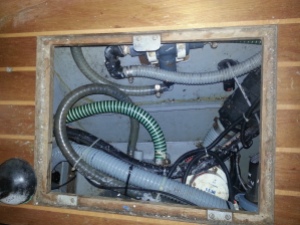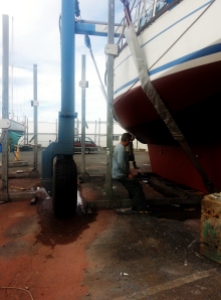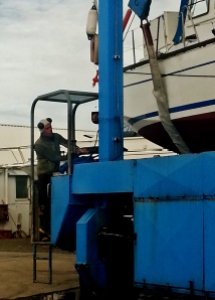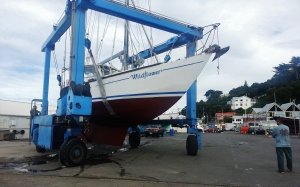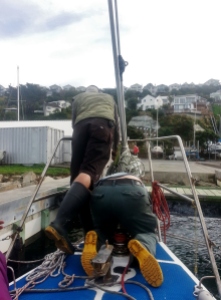Ollie – aka the handsomest cat in the world – (he made me write that) is a bit of a literary snob. He has told me I am not to review any books on this blog without running them past him first. Luckily two books arrived last week – Bailey Boat Cat – adventures of a feline afloat and Olly and Black Build a Boat – that received the paw of approval.
While both books star nautical moggies, Ollie himself is not a boat cat. When Ollie and I met Paddy and Wildflower Ollie was already somewhat of an Older Gentleman in cat terms and, while he is happy in the boat while it’s in the marina, going out to sea isn’t really his thing.
If you start a cat young on a boat they can adapt quite quickly – moggies have extremely sensitive inner-ears (which is why they have such great balance) and if exposed early can get to grips with the motion of a boat at sea. Though even the most seasoned purrate can get a bit sick from time to time so shade and hydration is really important.

Older cats though (with the odd exception) who have always lived on land and don’t have natural sea-legs can get very ill very quickly. We could perhaps get Ollie used to the motion by taking him on trips around the harbour but at nearly 13 years old we figure it wouldn’t be safe or fair to take him offshore.
Like any good armchair sailor though Ollie enjoys sharing the adventures of others (provided they are cats). Paddy and I have shared plenty of our stories with him but as far as he is concerned there are not nearly enough moggies involved.
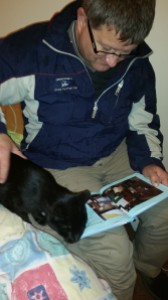
The arrival of both books came as a pleasant surprise, though Bailey Boat Cat a little less so – Ollie and I pre-ordered it a while ago but I had completely forgotten about it (Ollie says he hadn’t).
Bailey is a seal point Siamese who travels with his humans on a yacht (a Tayana 37) called Nocturne. Ollie and I have been following his adventures on his blog for quite some time and were very excited when the found out he had a book on the way. He even has a pretty awesome book trailer:
Bailey didn’t disappoint – with the aid of one his humans, Louise Kennedy, he has produced a gorgeous hardback gift book entirely from his own point of view (which Ollie of course thoroughly approved of).
I was particularly impressed with his navigation tips – which would have made studying for Boatmasters so much easier for me. I’ve previously blogged about Ollie’s own interest in navigation, which at the time I found rather irritating. Now I realise he was actually trying to point out the blindingly obvious to me and have apologised profusely for shoveling him off the charts instead of stopping to listen to him.
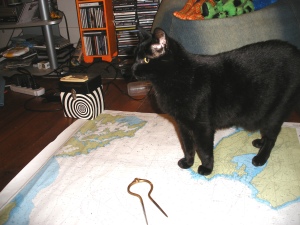
While I was struggling with latitudes, longitudes and two different Norths, Bailey had chart-work boiled down to five easy points;
- Look at the chart.
- Sail on the white bit.
- Anchor in the blue bit.
- Keep clear of the green bit.
- Buy treats in the brown and yellow areas
If only I had known it was that simple!
For me the book wasn’t just about the novelty of a cat on a boat though. For me it was also a reminder of the joy of being at sea. All the simple pleasures this salty sea-cat took in an environment so similar to Wildflower made me remember all the things I loved about our trip – not just the things that scared the pants off me. Sunshine, salty air, the wind on your face, star-gazing, visits from sea critters and making new friends. It helped me remember the magic.
Bailey also has some very sage advice for humans on work-life balance and what we could learn from cats that I think all of us should read.
So thanks Bailey. You’re adventures have got me inspired again and looking forward to more of my own.
Book number 2 – Olly and Black Build a Boat, came as a complete surprise. I was checking our PO Box, expecting nothing more than bills and voting papers when I picked up a surprise package.
One of my lovely Christchurch friends Jamie had sent me a Nick Cave mix tape (okay it’s a ‘mix CD’ but mix tape makes me feel like a teenager again!) because we’re heading to his concert in Wellington in December. He also added a couple of books he had picked up at the Riccarton Market – the Bowie Black Book (with some seriously drool-worthy photos) and an absolutely fabulous kids’ book staring a boat and a very handsome black cat.

It wasn’t exactly right because the human was called Olly and the cat Black – but it was so close to perfect we’ll let that one slide.
Ollie and Black Build a Boat is by Kiwi author Dick Oliver . Gorgeously illustrated it’s the classic man (and cat) alone, looking out to sea and dreaming of a boat of their own tale. Olly just happens to be a draughtsman however and in his lunch-breaks is actually able to design and, with the help of his furry friend, build one.
I noted that the cat in the book appeared to be particularly handy with boat polish (one of the chores usually delegated to me) but Ollie didn’t appear to be paying attention during that bit.
Ollie and Black Build a Boat also has great characters – I am particularly fond of Happy Jack “a happy man, with only two fingers on each hand and no teeth” who worked a portable sawmill deep in the forest.
Not only to Olly and Black build their boat but they get to use it to help their friends out when the town finds itself in trouble (but I won’t say any more because nobody likes spoilers!)
Ollie and I thoroughly recommend it for kids, cats and adults who refuse to grow up.

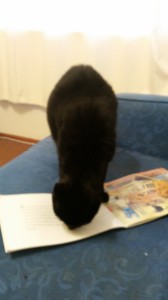




PS – for those waiting on an update on our own book (which Ollie says does not have enough cats in it but is okay because it includes him) I’m afraid I’ve only got a small one at this stage. It is being edited as we speak and I should have some pages to look at by the end of the month. Of course I know publishers are busy people and ours isn’t their only book so I’m not holding my breath too hard. I think I’m getting a little bit better at this waiting game – but it’s still tricky!







